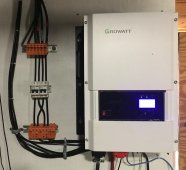They told me it would work, but to be aware of high inrush current, possibly several hundred amps, feeding into backwards transformer upon power up. I then contacted Ametherm, and pieced together an inrush current limiter/contactor solution to prevent tripping the load breakers on the Sol-Arks.
So far, it wasn't a problem for me. Feeding 120V legs I captured a peak of 80A for one cycle, within inverter's surge capability. Feeding in the forward direction (I have another transformer that does what I need), I saw 70A at 277V, similar current almost 2.5x the power during surge.
Sounds like you use a delayed relay to short out the Antherm thermistor, which should be an improvement over always having it in the circuit.
How much steady-state current does the the transformer draw? When I drove mine in the forward direction, from a 277/480Y transformer into its 480 delta, I got 1 Arms, something around 800 VA no-load. Haven't determined how much of that is "real" loss vs. reactive, and haven't checked inverter power consumption feed it.
Are you trying to use the delta transformer as split phase 120/240, or three phase 120/208? To source 120v you’re going to need a proper ground at the load point, or possible rewire the receiving transformer in a grounded wye configuration.
If you’re trying to use only two legs of three phase delta transformer that maybe the issue.
I initially fed a single 120V phase from an extension cord which gave the worst result. It has 3-leg "E" core, so the three phase windings interact.
I then drove 120/208Y from 3x Sunny Island inverters configured 3-phase into the secondary. I left midpoint of transformer disconnected (wired with 3 + ground romex), but that shouldn't matter no load or symmetric load since neutral current could be zero.
My purpose in using the transformer is to step up 120/208Y to 480 delta, for a 3-phase solar inverter Sunny TriPower. That will work without neutral, but I want to protect inverter against seeing 480Vrms from ground (in the event a line shorts, becomes corner-grounded delta). I think I could do that with two single phase transformers wired in a "T" to find the midpoint, but I bought a "zigzag" transformer rated 600V 15A, which is the accepted way to do it. That would provide a neutral for 277/408Y.
But my problem with this particular transformer is it seems to be driven too far into saturation operating steady-state with 120/208Y input. Something about how it was designed, I suppose. It is rated 5.99% impedance, which does not seem to be uncommon. Some other brands are rated 2%. That may relate to how much leakage inductance on primary (and how much resistance.) This apparently means if 5.99% of rated voltage is applied to 480V secondary, and primary is shorted, it will carry full-load amps. At first I thought that also related to prospective fault current, but maybe not because core not saturated during such a test.
For OP, this topic is a heads-up that if stepping AC up and back down with transformers, using a transformer designed as "step-up" is the only guaranteed satisfactory solution. Transformers are not as reversible as I thought, and using a pair of identical transformers for step-up and step-down may or may not work; we're seeing differences between models.




